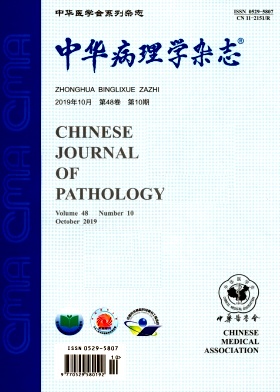侵袭性自然杀伤细胞白血病27例临床病理特点及预后分析
摘要
目的:探讨侵袭性自然杀伤细胞白血病(ANKL)的临床病理特点、诊断及预后。方法:回顾性分析2014 - 2024年南京医科大学第一附属医院收治的27例ANKL患者。回顾了他们的临床资料、组织形态学和免疫表型。采用Kaplan-Meier分析评估总生存期(OS), COX回归分析确定影响OS的预后因素。结果:27例患者中,男性18例,女性9例,男女比例为2∶1。年龄15 ~ 75岁,中位年龄42.0(28.5,54.5)岁。发热和脾肿大是最常见的体征和症状。大多数患者表现为全血细胞减少、凝血异常和肝功能障碍;所有患者的EBV载量均升高。镜下16例骨髓增生性明显,以间质浸润为主(15例,55.6%),其次为窦状浸润(3例)、弥漫性浸润(6例,22.2%)、混合性浸润(间质和局灶性浸润3例,11.1%)、局灶性浸润(2例,7.4%)、结节性浸润(1例,3.7%)。肿瘤细胞占有核细胞的比例为2% ~ 80%,中位数为30%。肿瘤细胞形态变化。23例患者出现噬血细胞现象。免疫组化结果显示,所有病例均表达CD56,多数表达细胞毒性分子(颗粒酶B、TIA-1)。Ki-67增殖指数为50% ~ 90%。CD56-EBER双染色显示NK细胞是病毒的主要靶点。网状蛋白染色显示纤维化增加。流式细胞术检测所有病例CD2阳性,表面CD3 (sCD3)、CD4、CD5和CD57阴性。其中21例(95.5%)表现为典型的CD56强表达(CD56str+)伴CD16阴性(CD16-)表型,仅有1例(4.5%)表现为CD16阳性(CD16+)伴CD56弱表达(CD56dim)表型。在杀伤细胞免疫球蛋白样受体(KIR)分析中,17例患者中有6例(6/17)表现出单克隆表达,包括CD158a(4/6)、CD158i(1/6)和CD158e (1/6);其余11例(11/17)完全不表达KIR。所有检测病例(17/17)t细胞受体(TCR)蛋白表达均为阴性。随访时间为257 d,失访1例,死亡26例。Kaplan-Meier分析显示,与未接受化疗的患者相比,接受化疗的患者的OS明显更长(ppp结论:侵袭性自然杀伤细胞白血病是一种罕见的淋巴恶性肿瘤,预后非常差。肿瘤细胞形态变化明显,骨髓浸润模式多样。准确识别、早期诊断、及时化疗是改善ANKL患者预后的关键。Objective: To investigate the clinicopathological features, diagnosis, and prognosis of aggressive natural killer-cell leukemia (ANKL). Methods: A retrospective analysis was conducted on 27 ANKL patients treated at the First Affiliated Hospital of Nanjing Medical University from 2014 to 2024. Their clinical data, histomorphology, and immunophenotype were reviewed. Kaplan-Meier analysis was used to evaluate the overall survival (OS), and COX regression analysis was performed to identify prognostic factors affecting OS. Results: Among the 27 patients, 18 were male and 9 were female, with a male-to-female ratio of 2∶1. The age ranged from 15-75 years, with a median age of 42.0 (28.5, 54.5) years. Fever and splenomegaly were the most common signs and symptoms. Most patients presented with pancytopenia, coagulation abnormalities, and liver dysfunction; and all patients had elevated EBV loads. Microscopically, 16 cases showed marked to hypercellular bone marrow proliferation, with predominant interstitial infiltration (15 cases, 55.6%), followed by sinusoidal infiltration (3 cases), diffuse infiltration (6 cases, 22.2%), mixed infiltration (interstitial and focal, 3 cases, 11.1%), focal infiltration (2 cases, 7.4%), and nodular infiltration (1 case, 3.7%). The proportion of tumor cells among nucleated cells ranged from 2% to 80%, with a median of 30%. The tumor cells displayed variable morphology. Hemophagocytosis was observed in 23 cases. Immunohistochemistry revealed that all cases expressed CD56, with mostly expressing cytotoxic molecules (granzyme B, TIA-1). The Ki-67 proliferative index ranged from 50% to 90%. CD56-EBER dual staining showed that NK cells were the primary targets of the virus. Reticulin staining showed increased fibrosis. By flow cytometry, all cases were positive for CD2 but negative for surface CD3 (sCD3), CD4, CD5 and CD57. Among them, 21 cases (95.5%) exhibited a typical phenotype of strong CD56 expression (CD56str+) with CD16 negativity (CD16-), while only one case (4.5%) showed CD16 positivity (CD16+) with dim CD56 expression (CD56dim). In killer-cell immunoglobulin-like receptor (KIR) analysis, 6 out of 17 patients (6/17) demonstrated monoclonal expression, including CD158a (4/6), CD158i (1/6), and CD158e (1/6); the remaining 11 cases (11/17) showed complete absence of KIR expression. All tested cases (17/17) were negative for T-cell receptor (TCR) protein expression. Follow-up period was from 257 days, 1 patient was lost to follow-up, and the remaining 26 patients died. Kaplan-Meier analysis revealed that OS was significantly longer in patients who received chemotherapy compared to those who did not (P<0.05). Univariate Cox proportional hazards model analysis indicated that age, bone marrow proliferation, proportion of tumor cells among nucleated cells, absolute neutrophil count, platelet count, and triglycerides and bilirubin levels significantly affected OS (P<0.05). Multivariate COX regression analysis identified triglycerides and bilirubin levels as independent prognostic factors for OS. Conclusion: Aggressive natural killer-cell leukemia is a rare lymphoid malignancy with very poor prognosis. Tumor cells exhibit significant morphological variation, and bone marrow infiltration patterns are diverse. Accurate recognition, early diagnosis, and timely chemotherapy are critical to improving the prognosis of patients with ANKL.

 求助内容:
求助内容: 应助结果提醒方式:
应助结果提醒方式:


